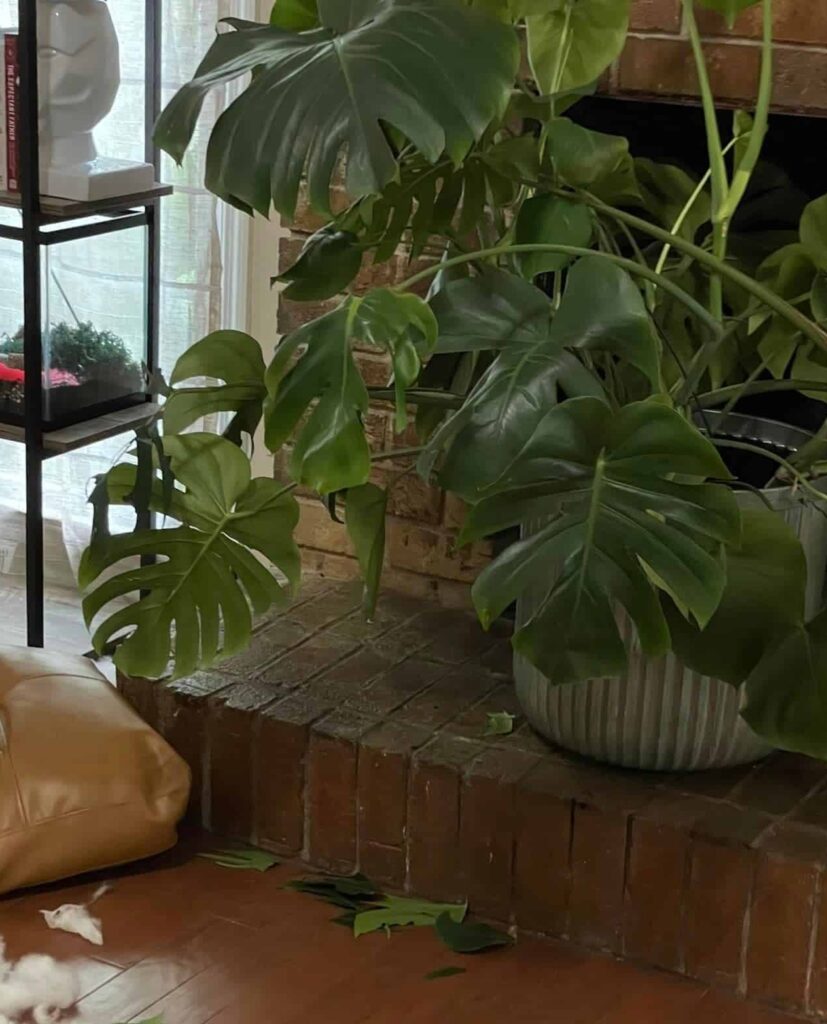Swiss-Cheese, or Monstera, is a magnificent tropical houseplant adapting quickly to any indoor environment.
But they never jell with your dogs and are toxic to your pup!
Unfortunately, dogs may curiously nibble down the parts of your Monstera, bringing forth grave trouble.
So, to protect your dogs and for guidance in such emergencies, comply and keep reading.
Table of Contents Show
Why is Monstera Toxic to Dogs?
Despite their hospitable nature, Monstera plants are highly toxic to dogs and mildly toxic to humans.
However, the toxicity can vary between the species, depending on the concentration of the crystals present in the plant.

When dogs consume or lick the plant parts of Monstera, calcium oxalate reaches their stomach and gets absorbed in the bloodstream, where it binds with the blood’s calcium.
Additionally, calcium oxalate crystals remain in the form of needle-like sharp “raphides” that can puncture the cells and tissues.
This can severely injure the kidneys, with other effects like breaking the membrane of the cells leading to irritation.
Symptoms and Diagnosis of Monstera Toxicity in Dogs
If your dog ingests the Monstera parts, the signs of poisoning will appear immediately within 30 seconds or may take 24-36 hours.
Although most immediate symptoms are not fatal, they gradually become scary.
These are some of the immediate symptoms that your dog can show.
- Irritation or burning sensation around the mouth, eyes, and skin
- Excessive drooling
- Difficulties in breathing and swallowing
- Constant panting
- Hoarse barks
- Swollen wind and food pipe
Without proper treatment, these symptoms can slowly become severe.
- Vomiting and diarrhea
- Tremors and muscle spasms
- Deposition of oxalate stones in the urine
- Kidney damage
Before your dog succumbs to the symptoms, you can diagnose whether the poisoning is due to consuming Monstera plant parts.
For a proper diagnosis, follow the steps below.
- Check for any bits of plant parts inside or around the dog’s mouth.
- Look whether your dog constantly paws at its face due to the irritation.
- Inspect your Monstera plant for bite or claw marks.
- Examine the potting soil of the plant for paw prints.

Sometimes, the symptoms are impossible to tell as they may match with other similar poisoning symptoms.
If you are still anxious and unsure whether your dog is having difficulty, visit your veterinarian or give a call to register an emergency case.
First Aid and Treatment Against Monstera Poisoning
Symptoms may take time to surface or can appear promptly depending on the quantities of plant parts consumed and the Monstera species.
If your dog shows severe symptoms after ingestion, an on-the-spot first aid treatment can be helpful to provide some relief to your pup.
- Remove the remaining Monstera parts from the dog’s mouth.
- Lay your dog in an open space and wrap it with a towel.
- Give some water or yogurt to your dog to flush out the toxins.
- Don’t force your dog to vomit; the disgorged raphide crystals may irritate their throat.
- Instead, feed your dog 1-3 grams of activated carbon to evoke self-vomiting.
- Wash their eyes, mouth or skin with milk.
In these kinds of emergencies, it’s always necessary to be equipped with a pet medical kit.
However, taking your dog to a vet is ideal if the symptoms persist and start to surge.
Recovery from Monstera Poisoning
In severe cases, your veterinarian may keep your dog in the clinic for a few hours or overnight to observe.
Once your vet allows a discharge, your dog should be fine to go home.
However, even after going home, do not expect your pup to be fit instantly, as normalizing may take at least 12-24 hours.

Your pet may suffer from appetite loss for 1-2 days.
Furthermore, the vet may also recommend a mild diet like boiled chicken or turkey and starchy food like cooked rice or sweet potato.
Additionally, provide your dog with plenty of fresh water to drink.
How to Prevent Your Dog from Eating Monstera?
We must take measures and ensure poisonous plants like Monstera are out of reach from dogs.
So, here are some tips to prevent your dog from eating Monstera.
- Keep your plant away on the top of a tall shelf or hanging baskets.
- If the plant is grounded or heavy to lift or move, spray pet deterrents around the plant, like vinegar, citrus juice, or pepper.
- Hang licking mats around the plants to keep your dogs occupied.

- You can also cone your dog and prevent it from nibbling the plant parts.
- Enrich the surrounding with toys to distract your dog.
- Train your dog to keep them away from the plant and offer them treats for good behavior.
FAQs About Monstera Toxicity in Dogs
Is Monstera Fruit Toxic to Dogs?
Monstera fruit also contains enough calcium oxalate to render your dog sick. The unripe fruit is also toxic to humans.
Can your Dog Lick Monstera Leaf and Remain Safe?
The sap of Monstera is present in all the parts containing the main toxin.
If the sap comes in contact with the mouth parts of your dog, it may immediately start showing side effects.
From Editorial Team
Don’t Be a Vet to Treat Your Pet!
Your dog may be your best friend, and it’s impossible to see it in agony, but never attempt to provide it with any kind of medication yourself.
Instead, you can offer some relief to your dog with on-site first aid treatment or leave the care in the hands of professionals.


